|
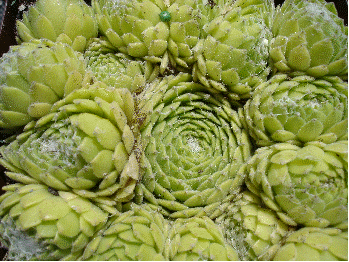 Hens
& chicks, botanically sempervivum, are interesting plants. Their
common name refers to how the plants grow. There is a mother plant,
or "hen," surrounded by baby plants, the "chicks."
They are low-growing, evergreen plants that form dense rosettes of
mothers and babies. Because they are evergreen, they are attractive
in the garden all year long. Hens
& chicks, botanically sempervivum, are interesting plants. Their
common name refers to how the plants grow. There is a mother plant,
or "hen," surrounded by baby plants, the "chicks."
They are low-growing, evergreen plants that form dense rosettes of
mothers and babies. Because they are evergreen, they are attractive
in the garden all year long.
Hens & chicks are succulent, alpine plants that in their native
habitat of central and southern Europe grow at altitudes of 3,000 to
8,000 feet above sea level. Because they are succulents, they can
tolerate dry soil and they look especially nice growing in a stone
wall, where they spread out flat to fill in the voids between the
stones. They also grow well in a rock garden, as an edging at the
front of a flower bed, or in strawberry jars. I've also grown them in
a whiskey barrel where I drilled holes in the sides of the barrel and
inserted the plants into the holes. They are very easy to grow,
needing only a sunny spot and well-drained soil.
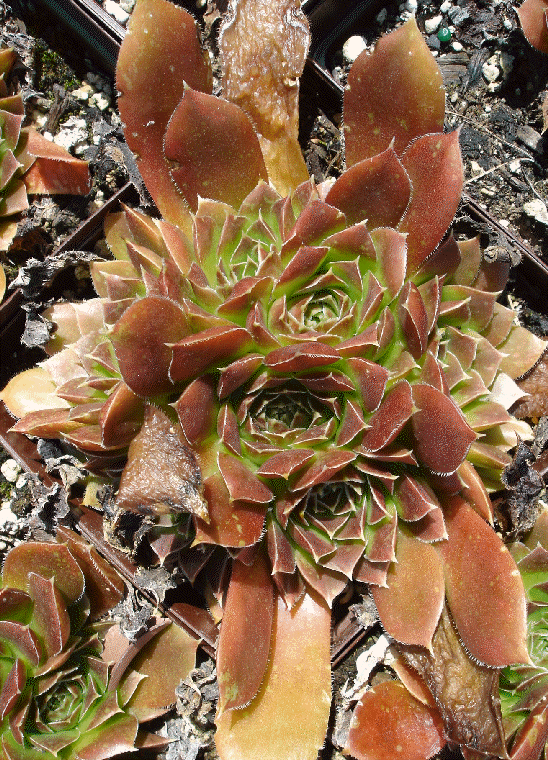 There
are many different sizes, leaf shapes, and colors in hens &
chicks. Leaf color includes green, gray, brown, silvery green, blue
green, red, and maroon. The leaf color is most pronounced when grown
in full sun. Many also change color with the seasons, being red or
maroon in spring, then changing to shades of green in summer, then
changing back to shades of red or maroon in fall and winter. Leaf
shape varies, as well. Some have long, slender leaves that fan out
from the center and others have short, upright or incurved leaves
that form a tight cluster. Plant size ranges from a few inches across
to over a foot wide or more. All stay very short, however, growing
only several inches high. There
are many different sizes, leaf shapes, and colors in hens &
chicks. Leaf color includes green, gray, brown, silvery green, blue
green, red, and maroon. The leaf color is most pronounced when grown
in full sun. Many also change color with the seasons, being red or
maroon in spring, then changing to shades of green in summer, then
changing back to shades of red or maroon in fall and winter. Leaf
shape varies, as well. Some have long, slender leaves that fan out
from the center and others have short, upright or incurved leaves
that form a tight cluster. Plant size ranges from a few inches across
to over a foot wide or more. All stay very short, however, growing
only several inches high. |
|
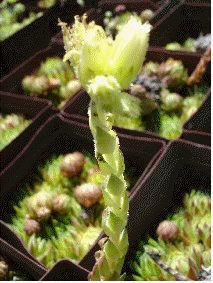 While
hens and chicks are grown primarily for their attractive leaves,
many also bloom. The small, star-shaped flowers are borne in small
clusters atop short, thick flower stems that rise through the center
of the rosette. Flower color is most often pink, although there are
some with pale-yellow flowers. While
hens and chicks are grown primarily for their attractive leaves,
many also bloom. The small, star-shaped flowers are borne in small
clusters atop short, thick flower stems that rise through the center
of the rosette. Flower color is most often pink, although there are
some with pale-yellow flowers.
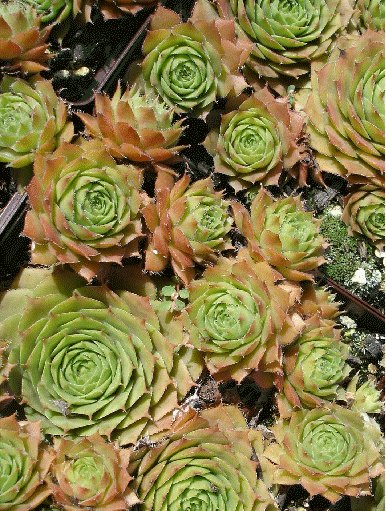 There
are about 50 different species of hens & chicks and over 3,000
different named varieties. Some of the showiest ones have attractive
bronze or maroon leaves. 'Old Copper'
forms large rosettes of showy, copper-colored leaves that keep their
coloration all year long. There
are about 50 different species of hens & chicks and over 3,000
different named varieties. Some of the showiest ones have attractive
bronze or maroon leaves. 'Old Copper'
forms large rosettes of showy, copper-colored leaves that keep their
coloration all year long.
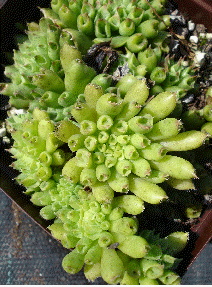 There
are also some unusual hens & chicks and one, aptly named 'Oddity'
certainly is odd. Instead of flattened or incurved leaves, this
variety has rounded, almost tubular, chartreuse-green leaves. In
spring, the tips of the leaves are tinged with maroon. The leaves are
held upright in dense rosettes and resemble short cinnamon sticks in
spring when their maroon coloration is most pronounced. There
are also some unusual hens & chicks and one, aptly named 'Oddity'
certainly is odd. Instead of flattened or incurved leaves, this
variety has rounded, almost tubular, chartreuse-green leaves. In
spring, the tips of the leaves are tinged with maroon. The leaves are
held upright in dense rosettes and resemble short cinnamon sticks in
spring when their maroon coloration is most pronounced.
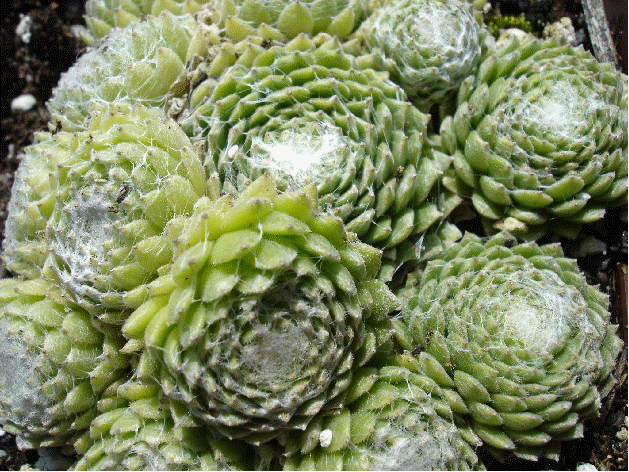 Another
interesting feature of some hens & chicks is what's known as
cobwebbing. Tiny, white hairs stretch across the tops of the rosettes
and in some varieties the hairs are so numerous that the very center
of the rosette is completely white. The cobwebbing even occurs on the
baby plantlets. Sempervivum
arachnoideum tomentosum has small rosettes held in clusters
with tight webbing across the centers. Another
interesting feature of some hens & chicks is what's known as
cobwebbing. Tiny, white hairs stretch across the tops of the rosettes
and in some varieties the hairs are so numerous that the very center
of the rosette is completely white. The cobwebbing even occurs on the
baby plantlets. Sempervivum
arachnoideum tomentosum has small rosettes held in clusters
with tight webbing across the centers. |



 Hens
& chicks, botanically sempervivum, are interesting plants. Their
common name refers to how the plants grow. There is a mother plant,
or "hen," surrounded by baby plants, the "chicks."
They are low-growing, evergreen plants that form dense rosettes of
mothers and babies. Because they are evergreen, they are attractive
in the garden all year long.
Hens
& chicks, botanically sempervivum, are interesting plants. Their
common name refers to how the plants grow. There is a mother plant,
or "hen," surrounded by baby plants, the "chicks."
They are low-growing, evergreen plants that form dense rosettes of
mothers and babies. Because they are evergreen, they are attractive
in the garden all year long. There
are many different sizes, leaf shapes, and colors in hens &
chicks. Leaf color includes green, gray, brown, silvery green, blue
green, red, and maroon. The leaf color is most pronounced when grown
in full sun. Many also change color with the seasons, being red or
maroon in spring, then changing to shades of green in summer, then
changing back to shades of red or maroon in fall and winter. Leaf
shape varies, as well. Some have long, slender leaves that fan out
from the center and others have short, upright or incurved leaves
that form a tight cluster. Plant size ranges from a few inches across
to over a foot wide or more. All stay very short, however, growing
only several inches high.
There
are many different sizes, leaf shapes, and colors in hens &
chicks. Leaf color includes green, gray, brown, silvery green, blue
green, red, and maroon. The leaf color is most pronounced when grown
in full sun. Many also change color with the seasons, being red or
maroon in spring, then changing to shades of green in summer, then
changing back to shades of red or maroon in fall and winter. Leaf
shape varies, as well. Some have long, slender leaves that fan out
from the center and others have short, upright or incurved leaves
that form a tight cluster. Plant size ranges from a few inches across
to over a foot wide or more. All stay very short, however, growing
only several inches high. While
hens and chicks are grown primarily for their attractive leaves,
many also bloom. The small, star-shaped flowers are borne in small
clusters atop short, thick flower stems that rise through the center
of the rosette. Flower color is most often pink, although there are
some with pale-yellow flowers.
While
hens and chicks are grown primarily for their attractive leaves,
many also bloom. The small, star-shaped flowers are borne in small
clusters atop short, thick flower stems that rise through the center
of the rosette. Flower color is most often pink, although there are
some with pale-yellow flowers. There
are about 50 different species of hens & chicks and over 3,000
different named varieties. Some of the showiest ones have attractive
bronze or maroon leaves.
There
are about 50 different species of hens & chicks and over 3,000
different named varieties. Some of the showiest ones have attractive
bronze or maroon leaves.  There
are also some unusual hens & chicks and one, aptly named
There
are also some unusual hens & chicks and one, aptly named  Another
interesting feature of some hens & chicks is what's known as
cobwebbing. Tiny, white hairs stretch across the tops of the rosettes
and in some varieties the hairs are so numerous that the very center
of the rosette is completely white. The cobwebbing even occurs on the
baby plantlets.
Another
interesting feature of some hens & chicks is what's known as
cobwebbing. Tiny, white hairs stretch across the tops of the rosettes
and in some varieties the hairs are so numerous that the very center
of the rosette is completely white. The cobwebbing even occurs on the
baby plantlets.  by
Pernell Gerver
by
Pernell Gerver